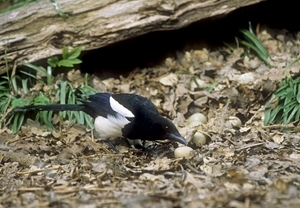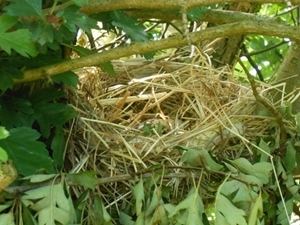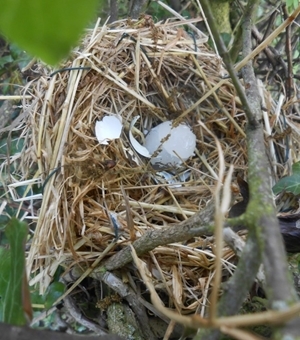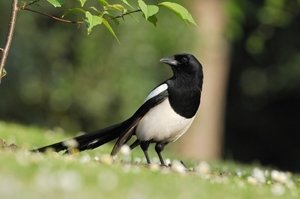Key points
- In the UK, farmland songbird populations have been declining since the 1960s. Over the same period, the populations of some nest predators, for example magpies and crows, have increased.
- Studies looking at predator removal have shown mixed results. Removing nest predators does not always benefit prey populations. This could be because predators vary in how they much they predate nests.
- This study used artificial nests to identify the factors that cause differences in nest predation on British farmland.
- Magpies were found to be the main predators of artificial nests in this study. Where predators could be identified, medium-sized birds were responsible for 70% of nest predation. Almost all (87%) of these seen in trail camera photos were magpies.
- Nest predation was higher inside magpie territories, but this increase was only apparent later in the breeding season.
- Identifying the factors that cause higher rates of nest predation could lead to better targeted habitat management and/or predator removal and help songbird populations throughout the UK.
Background
 In the UK, farmland songbird populations have been declining since the 1960s. Over a similar time period, populations of corvids (e.g. magpies and crows) have increased. These trends could be linked, because corvids eat the eggs and chicks from songbird nests. However, research has not always found that corvid removal has a positive effect on songbird numbers. These mixed outcomes could be because other factors affect whether corvids predate nests, like habitat or differences in behaviour between individual corvids.
In the UK, farmland songbird populations have been declining since the 1960s. Over a similar time period, populations of corvids (e.g. magpies and crows) have increased. These trends could be linked, because corvids eat the eggs and chicks from songbird nests. However, research has not always found that corvid removal has a positive effect on songbird numbers. These mixed outcomes could be because other factors affect whether corvids predate nests, like habitat or differences in behaviour between individual corvids.
Predator removal might only be effective when other factors result in high nest predation by corvids. For example, scientists expect the age, sex, and breeding status of corvids to affect their level of predation. Crows and magpies are territorial, and breeding pairs usually hunt within their own territory. This means they have an in-depth knowledge of a small area. As a result, breeding pairs might be more likely to find and predate songbird nests within their own territories, compared to non-breeders that don’t have a territory.
Individual corvids may display different behaviours, depending on their personality or experience. The risk of nest predation is also likely to change in different habitats. The thickness of the hedgerow and the design of songbird nests will affect how well hidden the nests are within hedgerows.
In this study, kindly funded by SongBird Survival, the scientists aimed to identify the main predators of artificial songbird nests and the factors that affect the risk of nest predation. This knowledge could help land managers and conservationists to target predator removal and habitat management better, and benefit songbird populations.
What they did
 This study took place in 2016 on farmland in Warwickshire. Between March and July, the authors placed 460 artificial songbird nests in hedgerows so they could monitor predation.
This study took place in 2016 on farmland in Warwickshire. Between March and July, the authors placed 460 artificial songbird nests in hedgerows so they could monitor predation.
Artificial nests were made by weaving hay and grass into chicken wire. The nests were designed to look like blackbird nests. Nests were baited with one real quail’s egg and one wax-filled quail’s egg. Nests were then placed in realistic positions in the hedgerow, where they were left for five days at a time.
The authors considered a nest to be predated if either of the eggs was missing or damaged. Two methods were used to identify the type of nest predator.
- Tooth or beak marks on the wax-filled eggs allowed the authors to classify predators into; medium-sized birds (e.g. magpie), small birds (e.g. robin), small mammals (e.g. rat), and unknown predators.
- Some nests were also monitored with motion sensitive trail cameras that took pictures when predators were in or near the nest.
The study looked at four factors that could cause differences in nest predation.
- Presence of breeding magpies – Magpie nests were found during winter when they are easily visible in trees. Then in spring, the authors revisited these magpie nests to find out whether the territory was occupied by a breeding pair. Some of the artificial songbird nests were placed in active magpie territories, and some were in randomly selected sites where there were no breeding magpies.
- Time in the breeding season – The authors put artificial nests in the same sites between March and July.
- Habitat differences – Nests were placed in different types of hedgerows. Hedgerows were grouped into two categories: open and closed. Open hedgerows were over 2m wide and contained a mixture of tree and shrub species. Closed hedgerows were less than 2m wide and mainly contained hawthorn and blackthorn.
- Individual differences between predators – The authors investigated differences in predation at specific sites to explore whether particular individuals predated more than others.
What they found
 In this study, 28% of the artificial songbird nests were predated. The authors identified three groups of predators: small birds, small mammals, and medium-sized birds. Small birds were not considered to be predators but seemed to interact with the artificial songbird nests. When predators could be identified (61% of predation cases), small mammals were found to be responsible for 23% of nest predation, while medium-sized birds were responsible for 70% of nest predation.
In this study, 28% of the artificial songbird nests were predated. The authors identified three groups of predators: small birds, small mammals, and medium-sized birds. Small birds were not considered to be predators but seemed to interact with the artificial songbird nests. When predators could be identified (61% of predation cases), small mammals were found to be responsible for 23% of nest predation, while medium-sized birds were responsible for 70% of nest predation.
The only small mammals that were recorded by trail cameras were rodents (rats and mice). The only medium-sized birds in the trail camera photos were corvids, and 87% of these photos were of magpies. This suggests that magpies were the main predator of artificial songbird nests in this study.
When the authors looked at variation in all nest predation, they found that predation was lower later in the breeding season. This is probably because plant growth meant the nests were more well-hidden. When the authors specifically analysed the differences in magpie predation, they found that predation was higher inside the territories of breeding pairs of magpies, but only late in the breeding season. This could be because this is when the magpies are feeding their own chicks.
The authors also found that nests in some locations suffered higher rates of predation than expected based on the other factors. Trail camera observations suggested that some individual magpies in these particular territories were more likely to predate nests. However, more research is required to understand individual variation.
What does this mean?
 This study found that magpies were the main predator of the artificial nests, but the impact of magpie predation varied. Nests inside breeding magpie territories were more likely to be predated late in the breeding season. Removing breeding magpies from a territory during this time could have a positive effect on songbirds, but the territory may then be taken over by other magpies with the same predatory behaviour.
This study found that magpies were the main predator of the artificial nests, but the impact of magpie predation varied. Nests inside breeding magpie territories were more likely to be predated late in the breeding season. Removing breeding magpies from a territory during this time could have a positive effect on songbirds, but the territory may then be taken over by other magpies with the same predatory behaviour.
This study suggests that the quality of hedgerow nesting habitat is also very important. Habitat management for songbirds should pay attention to this as much as to predator control. Suitable habitat management includes improving nesting habitat in areas where nests are more likely to be predated, such as areas near magpie nests.
Overall, the benefits of predator control and habitat management will be greater if land managers target management towards the songbird nests that are more likely to be predated.
This study used artificial songbird nests, and although studies have shown that these can experience the same pattern of predation as natural nests, it is important to remember that artificial nests may not accurately represent natural nest predation. For example, humans may not conceal nests as well as birds do, and the smell of wax eggs may attract rodents.
The results of this study come during a controversial time for predator control. The rules on which birds can be killed to protect wild birds, crops and livestock has recently changed. Until 2019, magpies could be killed for the conservation of other wild birds, however the supporting evidence for that practice has been questioned and the future of the General Licence in England is under review.
Thank you to SongBird Survival for funding this research.
Read the original paper
Capstick, L.A., Sage, R.B. & Madden, J.R. Predation of artificial nests in UK farmland by magpies (Pica pica): interacting environmental, temporal, and social factors influence a nest’s risk. European Journal of Wildlife Research 65, 50 (2019).